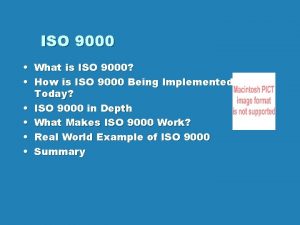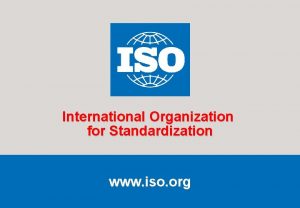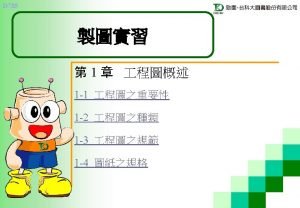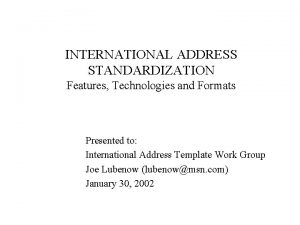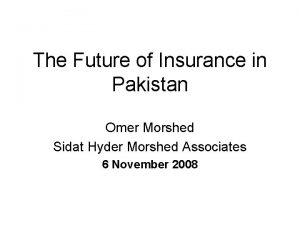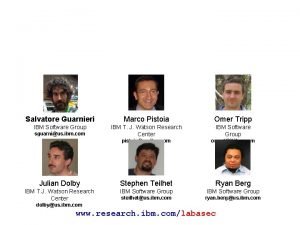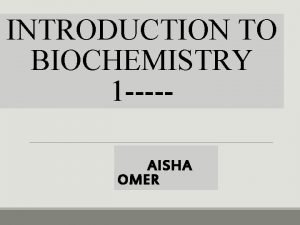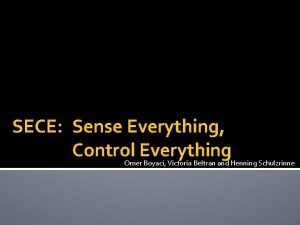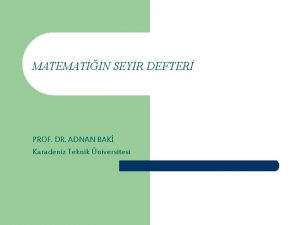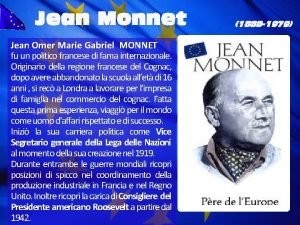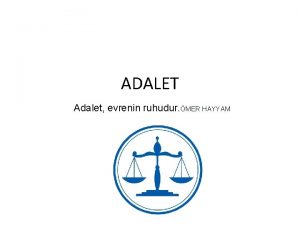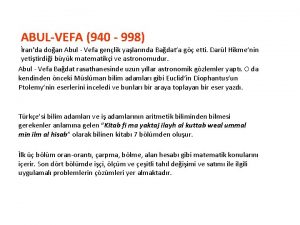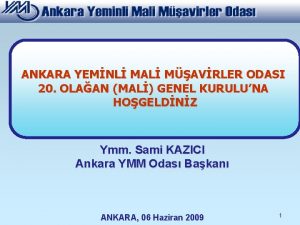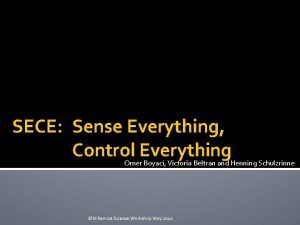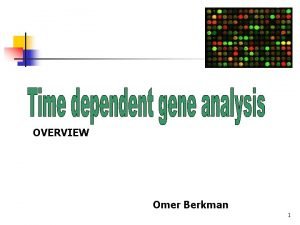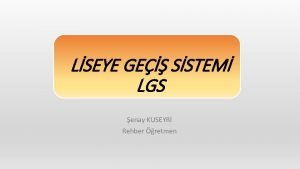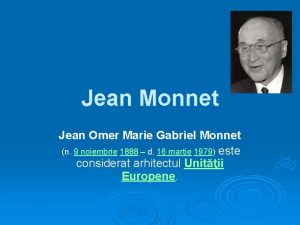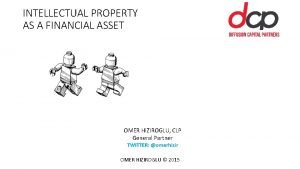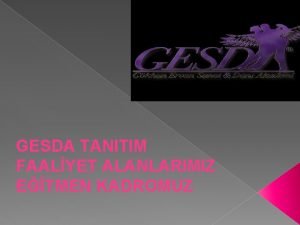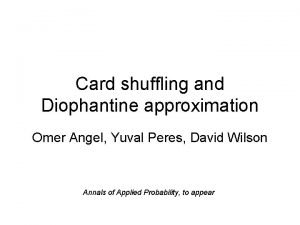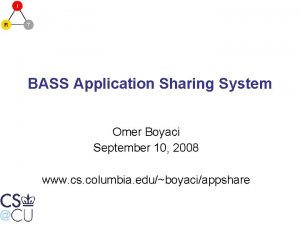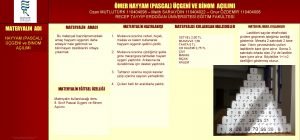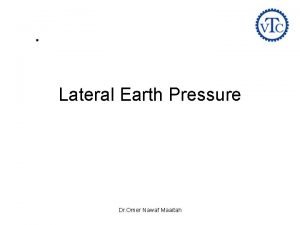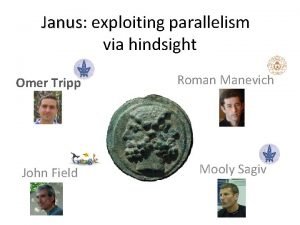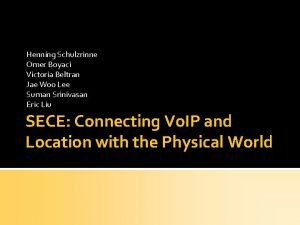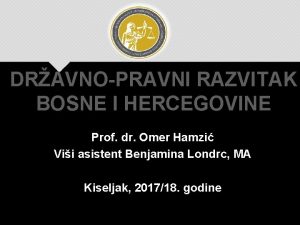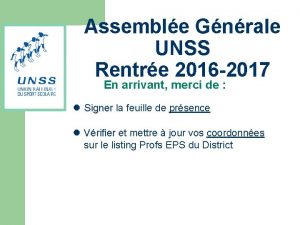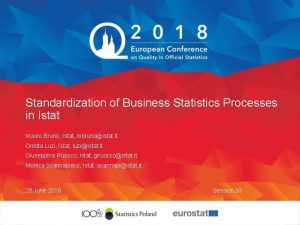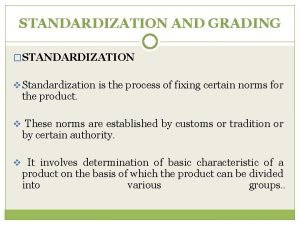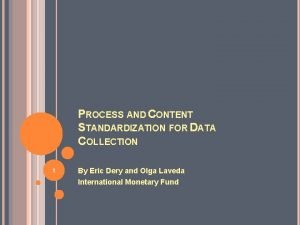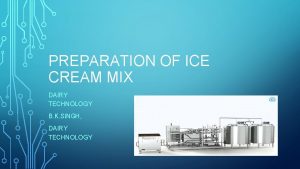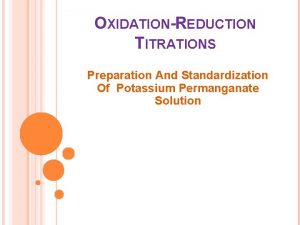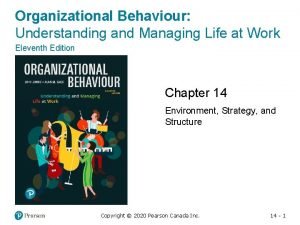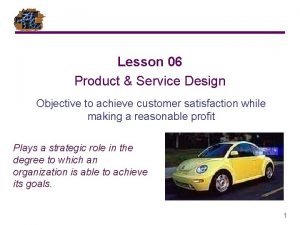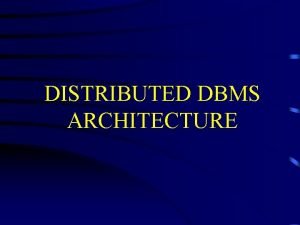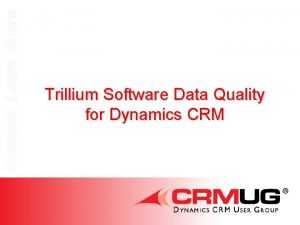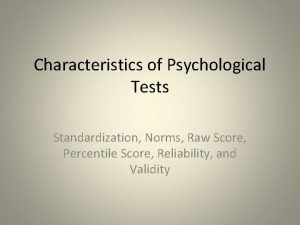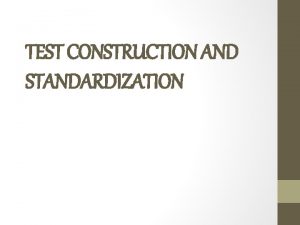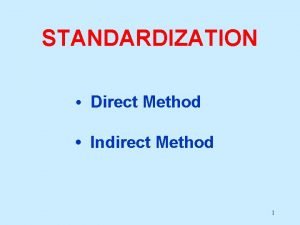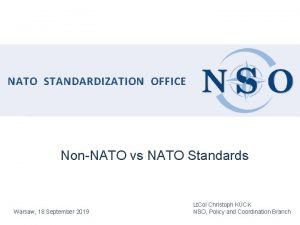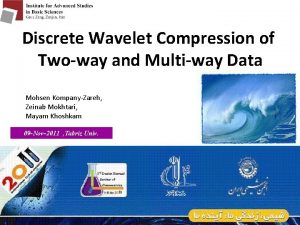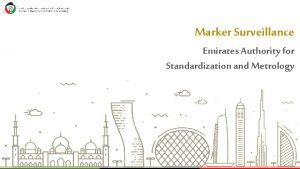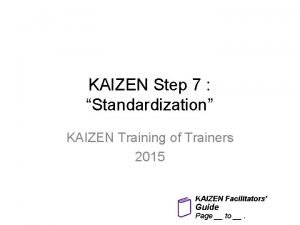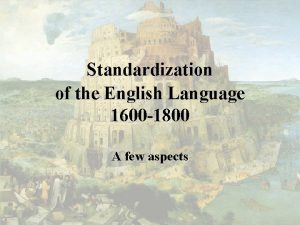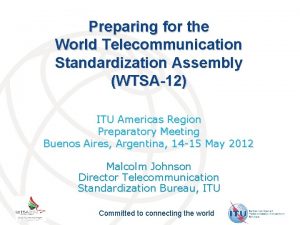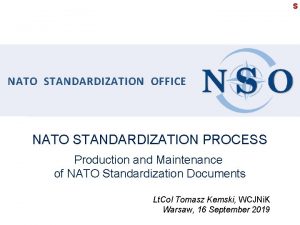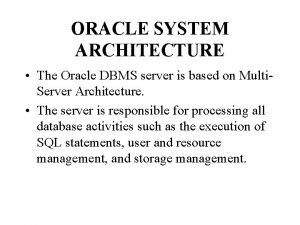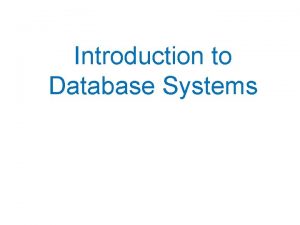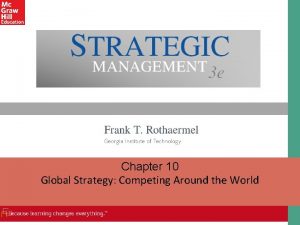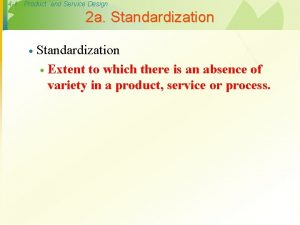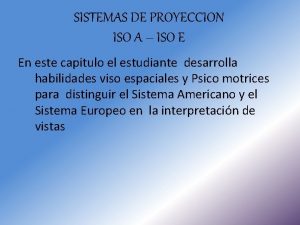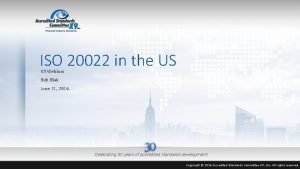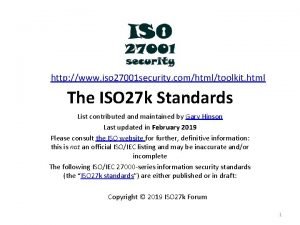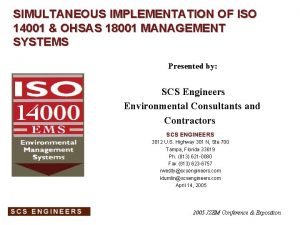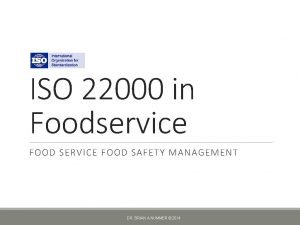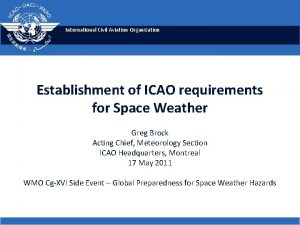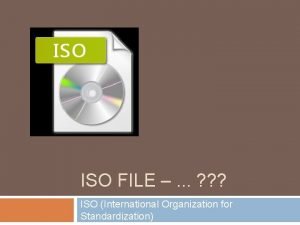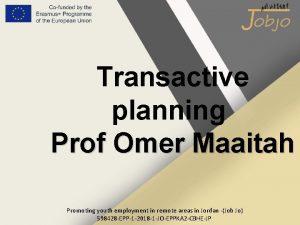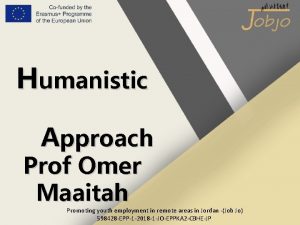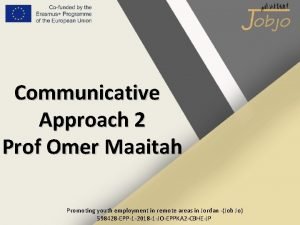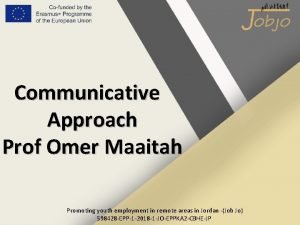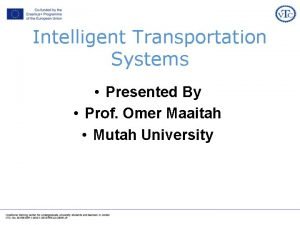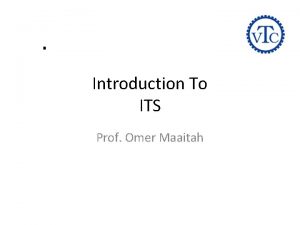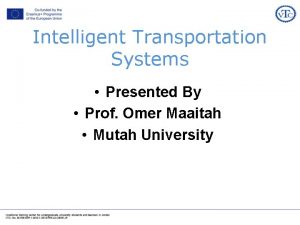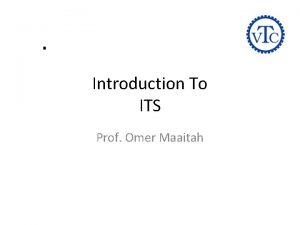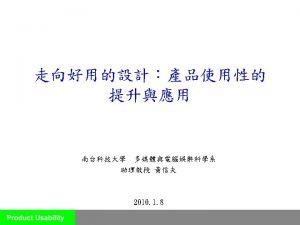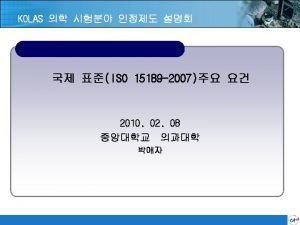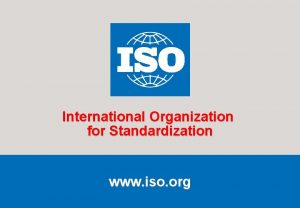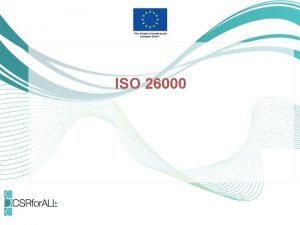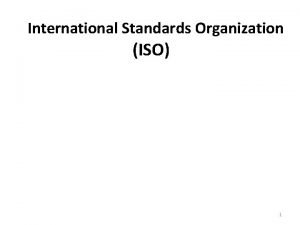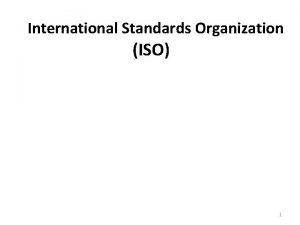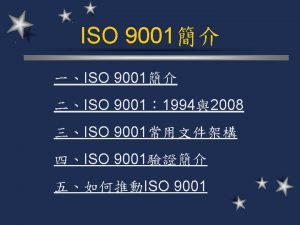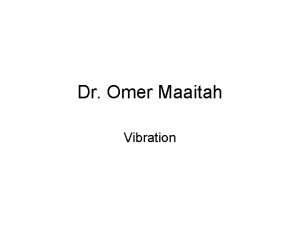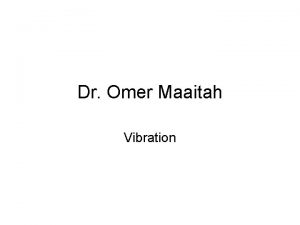ISO International Organization for Standardization Prof Omer Maaitah












































































































































- Slides: 140

" ISO" International Organization for Standardization • Prof Omer Maaitah Promoting youth employment in remote areas in Jordan -(Job Jo) 598428 -EPP-1 -2018 -1 -JO-EPPKA 2 -CBHE-JP

" ISO" International Organization for Standardization • International Organization for Standardization • " Organisation internationale de normalisation • • Formation 23 February 1947 Type NGO Purpose/focus International standard Headquarters Geneva , Switzerland Membership 157 members Official languages English and French Website www. iso. org

• The International Organization for Standardization )Organisation internationale de normalisation , ( widely known as ISO) • Pronounced ɑɪsəʊ • Is an international-standard-setting body composed of representatives from various national standards organizations. • Founded on 23 February , 1947 the organization promulgates world-wide proprietary industrial and commercial standards

• It is headquartered in Geneva , Switzerland • While ISO defines itself as a non-governmental organization , its ability to set standards that often become law, either through treaties or national standards, makes it more powerful than most non-governmental organizations. • In practice, ISO acts as a consortium with strong links to governments.


standards bodies who are ISO members • A map of • Key: • members • correspondent members • subscriber members • other places with an ISO 3166 -1 code, who aren't members of ISO

• ISO has 157 national members out of the 195 total countries in the world. • ISO has three membership categories: • Member bodies are national bodies that are considered to be the most representative standards body in each country. • These are the only members of ISO that have voting rights.

• Correspondent members are countries that do not have their own standards organization. • These members are informed about ISO's work, but do not participate in standards promulgation.

• Subscriber members are countries with small economies. • They pay reduced membership fees, but can follow the development of standards. • Participating members are called "P" members as opposed to observing members which are called "O" members.

ISO 9000 • ISO 9000 is a family of standards for quality management systems. • ISO 9000 is maintained by ISO, the International Organization for Standardization and is administered by accreditation and certification bodies. • Some of the requirements in ISO 9001 (which is one of the standards in the ISO 9000 family) include:

ISO 9001 requirements 1. A set of procedures that cover all key processes in the business ; 2. Monitoring processes to ensure they are effective ; 3. Keeping adequate records ; 4. Checking output for defects, with appropriate and corrective action where necessary ; 5. Regularly reviewing individual processes and the quality system itself for effectiveness; and 6. Facilitating continual improvement

Understandings: • A company or organization that has been independently audited and certified to be in conformance with ISO 9001 may publicly state that it is "ISO 9001 certified" or "ISO 9001 registered. " • Certification to an ISO 9000 standard does not guarantee the compliance (and therefore the quality) of end products and services; rather, it certifies that consistent business processes are being applied. • Indeed, some companies enter the ISO 9001 certification as a marketing tool.

• Although the standards originated in manufacturing , they are now employed across a wide range of other types of organizations. • A "product", in ISO vocabulary, can mean a physical object, or services, or software. • In fact, according to ISO in 2004" , service sectors now account by far for the highest number of ISO 9001: 2000 certificates - about 31% of the total".

The standard specifies six compulsory documents: 1. Control of Documents (4. 2. 3) 2. Control of Records (4. 2. 4) 3. Internal Audits (8. 2. 2) 4. Control of Nonconforming Product / Service (8. 3) 5. Corrective Action (8. 5. 2) 6. Preventive Action (8. 5. 3) In addition to these, ISO 9001: 2000 requires a Quality Policy and Quality Manual (which may or may not include the above documents. )

Summary of ISO 9001: 2000 in informal language • The quality policy is a formal statement from management, closely linked to the business and marketing plan and to customer needs. • The quality policy is understood and followed at all levels and by all employees. • Each employee needs measurable objectives to work towards.

• Decisions about the quality system are made based on recorded data and the system is regularly audited and evaluated for conformance and effectiveness. • Records should show and where raw materials and products were processed, to allow products and problems to be traced to the source.

• You need a documented procedure to control quality documents in your company. • Everyone must have access to up-to-date documents and be aware of how to use them. • To maintain the quality system and produce conforming product, you need to provide suitable infrastructure, resources, information, equipment, measuring and monitoring devices, and environmental conditions.

• You need to map out all key processes in your company; control them by monitoring, measurement and analysis; and ensure that product quality objectives are met. • If you can’t monitor a process by measurement, then make sure the process is well enough defined that you can make adjustments if the product does not meet user needs

• For each product your company makes, you need to establish quality objectives; plan processes; and document and measure results to use as a tool for improvement. • For each process, determine what kind of procedural documentation is required (note: a “product” is hardware, software, services, processed materials, or a combination of these. )

• You need to determine key points where each process requires monitoring and measurement, and ensure that all monitoring and measuring devices are properly maintained and calibrated

• You need to have clear requirements for purchased product. • You need to determine customer requirements and create systems for communicating with customers about product information, inquiries, contracts, orders, feedback and complaints.

• When developing new products, you need to plan the stages of development, with appropriate testing at each stage. • You need to test and document whether the product meets design requirements, regulatory requirements and user needs.

• You need to regularly review performance through internal audits and meetings. • Determine whether the quality system is working and what improvements can be made. • Deal with past problems and potential problems. • Keep records of these activities and the resulting decisions, and monitor their effectiveness (note: you need a documented procedure for internal audits. )

• You need documented procedures for dealing with actual and potential non-conformances (problems involving suppliers or customers, or internal problems). • Make sure no one uses bad product, determine what to do with bad product, deal with the root cause of the problem and keep records to use as a tool to improve the system

2000 version • ISO 9001: 2000 combines the three standards 9001, 9002, and 9003 into one, called 9001. • Design and development procedures are required only if a company does in fact engage in the creation of new products. • The 2000 version sought to make a radical change in thinking by actually placing the concept of process management front and center ("Process management" was the monitoring and optimizing of a company's tasks and activities, instead of just inspecting the final product).

• The 2000 version also demands involvement by upper executives, in order to integrate quality into the business system and avoid delegation of quality functions to junior administrators. • Another goal is to improve effectiveness via process performance metrics — numerical measurement of the effectiveness of tasks and activities. • Expectations of continual process improvement and tracking customer satisfaction were made explicit

Future version: 2008 • TC 176, the ISO 9001 technical committee, has started its review on the next version of ISO 9001, which will in all likelihood be termed the ISO 9001: 2008 standard, assuming its planned release date of 2008 is met. • Early reports are that the standard will not be substantially changed from its 2000 version.

• As with the release of previous versions, organizations registered to ISO 9001 will be given a substantial period to transition to the new version of the standard, assuming changes are needed; organizations registered to 9001: 1994 had until December of 2003 to undergo upgrade audits. • The forthcoming ISO 9001: 2008 international standard is likely to be published by October November 2008.

Certification • ISO does not itself certify organizations. • Many countries have formed accreditation bodies to authorize certification bodies, which audit organizations applying for ISO 9001 compliance certification. • Although commonly referred to as ISO 9000: 2000 certification, the actual standard to which an organization's quality management can be certified is ISO 9001: 2000.

• Both the accreditation bodies and the certification bodies charge fees for their services. • The various accreditation bodies have mutual agreements with each other to ensure that certificates issued by one of the Accredited Certification Bodies) CB) are accepted worldwide.

• The applying organization is assessed based on an extensive sample of its sites, functions, products, services and processes; a list of problems ("action requests" or "non-compliances") is made known to the management. • If there are no major problems on this list, the certification body will issue an ISO 9001 certificate for each geographical site it has visited, once it receives a satisfactory improvement plan from the management showing how any problems will be resolved.

• An ISO certificate is not a once-and-for-all award, but must be renewed at regular intervals recommended by the certification body, usually around three years. • In contrast to the Capability Maturity Model there are no grades of competence within ISO 9001.

Auditing • Two types of auditing are required to become registered to the standard: auditing by an external certification body )external audit (and audits by internal staff trained for this process) internal audits( • The aim is a continual process of review and assessment, to verify that the system is working as it's supposed to, find out where it can improve and to correct or prevent problems identified. • It is considered healthier for internal auditors to audit outside their usual management line, so as to bring a degree of independence to their judgments. • Under the 1994 standard, the auditing process could be adequately addressed by performing "compliance auditing

• Tell me what you do) describe the business process( • Show me where it says that) reference the procedure manuals( • Prove that is what happened) exhibit evidence in documented records( • How this led to preventive actions was not clear. • The 2000 standard uses the process approach. • While auditors perform similar functions, they are expected to go beyond mere auditing for rote "compliance" by focusing on risk, status and importance.

• This means they are expected to make more judgments on what is effective, rather than merely adhering to what is formally prescribed. • The difference from the previous standard can be explained thus: – Under the 1994 version, the question was broadly "Are you doing what the manual says you should be doing? ", whereas under the 2000 version, the question is more "Will this process help you achieve your stated objectives? Is it a good process or is there a way to do it better. "? • The ISO 19011 standard for auditing applies to ISO 9001 besides other management systems like EMS ( ISO 14001), FSMS (ISO 22000) etc.

Debate on the effectiveness of ISO 9000 • The debate on the effectiveness of ISO 9000 commonly centers on the following questions: • Are the quality principles in ISO 9000: 2000 of value (note that the version date is important: in the 2000 version ISO attempted to address many concerns and criticisms of ISO 9000: 1994 ? ( • Does it help to implement an ISO 9001: 2000 compliant quality management system ? • Does it help to obtain ISO 9001: 2000 certification ?

Advantages • It is widely acknowledged that proper quality management improves business, often having a positive effect on investment, market share, sales growth, sales margins, competitive advantage, and avoidance of litigation • The quality principles in ISO 9000: 2000 are also sound, according to Wade, and Barnes , who says "ISO 9000 guidelines provide a comprehensive model for quality management systems that can make any competitive. "

• Barnes also cites a survey by Lloyd's Register Quality Assurance which indicated that ISO 9000 increased net profit, and another by Deloitte-Touche which reported that the costs of registration were recovered in three years. • According to the Providence Business News, implementing ISO often gives the following advantages:

1. 2. 3. 4. 5. Create a more efficient, effective operation Increase customer satisfaction and retention Reduce audits Enhance marketing Improve employee motivation, awareness, and morale 6. Promote international trade 7. Increases profit 8. Reduce waste and increases productivity

• However, a broad statistical study of 800 Spanish companies, found that ISO 9000 registration in itself creates little improvement because companies interested in it have usually already made some type of commitment to quality management and were performing just as well before registration.

• In today's service-sector driven economy, more and more companies are using ISO 9000 as a business tool. • Through the use of properly stated quality objectives, customer satisfaction surveys and a well-defined continual improvement program companies are using ISO 9000 processes to increase their efficiency and profitability.

Problems • A common criticism of ISO 9001 is the amount of money, time and paperwork required for registration • According to Barnes, "Opponents claim that it is only for documentation. • Proponents believe that if a company has documented its quality systems, then most of the paperwork has already been completed

• According to Seddon, ISO 9001 promotes specification, control, and procedures rather than understanding and improvement • Wade argues that ISO 9000 is effective as a guideline, but that promoting it as a standard "helps to mislead companies into thinking that certification means better quality, . . . [undermining] the need for an organization to set its own quality standards". • Paraphrased, Wade's argument is that total, blind reliance on the specifications of ISO 9001 does not guarantee a successful quality system.

• The standard is seen as especially prone to failure when a company is interested in certification before quality • Certifications are in fact often based on customer contractual requirements rather than a desire to actually improve quality“ • If you just want the certificate on the wall, chances are, you will create a paper system that doesn't have much to do with the way you actually run your business, " said ISO's Roger Frost

• Certification by an independent auditor is often seen as the problem area, and according to Barnes, "has become a vehicle to increase consulting services • In fact, ISO itself advises that ISO 9001 can be implemented without certification, simply for the quality benefits that can be achieved.

• Another problem reported is the competition among the numerous certifying bodies, leading to a softer approach to the defects noticed in the operation of the Quality System of a firm.

ISO 14000 • The ISO 14000 environmental management standards exist to help organizations minimize how their operations negatively affect the environment (cause adverse changes to air, water, or land) and comply with applicable laws and regulations.

• ISO 14001 is the international specification for an environmental management system) EMS). • It specifies requirements for establishing an environmental policy, determining environmental aspects and impacts of products/activities/services, planning environmental objectives and measurable targets, implementation and operation of programs to meet objectives and targets, checking and corrective action, and management review.

• ISO 14000 is similar to ISO 9000 quality management in that both pertain to the process (the comprehensive outcome of how a product is produced) rather than to the product itself. • The overall idea is to establish an organized approach to systematically reduce the impact of the environmental aspects which an organization can control. • Effective tools for the analysis of environmental aspects of an organization and for the generation of options for improvement are provided by the concept of Cleaner Production.

• As with ISO 9000, certification is performed by third-party organizations rather than being awarded by ISO directly. • The ISO 19011 audit standard applies when auditing for both 9000 and 14000 compliance at once.

Standards • The material included in this family of specifications is very broad. • The major parts of ISO 14000 are: • ISO 14001 is the standard against which organizations are assessed. • ISO 14001 is generic and flexible enough to apply to any organization producing and/or manufacturing any product, or even providing a service anywhere in the world

• ISO 14004 is a guidance document that explains the 14001 requirements in more detail. • These present a structured approach to setting environmental objectives and targets and to establishing and monitoring operational controls.

• These are further expanded upon by the following: • ISO 14020 series (14020 to 14025), Environmental Labeling, covers labels and declarations. • ISO 14030 discusses post-production environmental assessment. • ISO 14031 Evaluation of Environmental Performance. • ISO 14040 series (14040 to 14044 , (Life Cycle Assessment, LCA , discusses pre-production planning and environment goal setting.

• ISO 14050 terms and definitions. • ISO 14062 discusses making improvements to environmental impact goals. • ISO 14063 is an addendum to 14020, discussing further communications on environmental impact.

• Is Greenhouse gases – Part 1: Specification with guidance at the organization level for the description, quantification and reporting of greenhouse gas emissions and removals. • Is Greenhouse gases – Part 2: Specification with guidance at the project level for the description, quantification, monitoring and reporting of greenhouse gas emission reductions and removal enhancements.

• Is Greenhouse gases – Part 3: Specification with guidance for the validation and verification of greenhouse gas assertion.

• ISO 19011 which specifies one audit protocol for both 14000 and 9000 series standards together. • This replaces ISO 14011 meta-evaluation— how to tell if your intended regulatory tools worked. • 19011 is now the only recommended way to determine this.

Environmental management system • The Environmental Management System )EMS) is part of a management system of an organization) enterprise, authority, etc. ), in which specific competencies, behaviours, procedures and demands for the implementation of an operational environmental policy of the organization are defined.

Legislation and standards • Within the European Union (EU) legislation was introduced to encourage businesses to voluntarily adopt ISO 14000. • Regulation (EC) No 761/2001 of the European Parliament and of the Council of 19 March 2001, allowed voluntary participation by organisations in a Community ecomanagement and audit scheme Eco-Management and Audit Scheme) EMAS. ( • The implementation of a robust EMS, which may incorporate ISO 14001, should lead to improved environmental performance, including better and more consistent legal compliance.

• The ISO 14000 standards reflect different aspects of environmental management. The following list outlines the broad coverage of each: • Environmental Management Systems : – 14004 , 14002 , 14001 • Environmental Auditing : – 19011 • Environmental Labeling : – 14025 , 14024 , 14023 , 14022 , 14021 , 14020 • Life Cycle Assessment : – 14043 , 14042 , 14041 , 14040

Benefits • There a range of benefits associated with operating an effective Environmental Management Systems (EMS)

Financial • Cost savings through the reduction of waste and more efficient use of natural resources (electricity, water, gas and fuels (. • Avoiding fines and penalties from not meeting environmental legislation by identifying environmental risks and addressing weaknesses. • Reduction in insurance costs by demonstrating better risk management

Operational and Internal • Improved overall performance and efficiency. • Able to monitor and reflect (audit) your businesses and see which areas need intervention

External • Better public perception of the organization, leading to improved sales • Reduction of the impact (e. g. noises, smells, dust) of your activities on the local residents, leading to more community support

ISO 9000

• The previous members of the ISO 9000 family, 9001, 9002 and 9003, have all been integrated into 9001. • In most cases, an organization claiming to be "ISO 9000 registered" is referring to ISO 9001.

• Records should show and where raw materials and products were processed, to allow products and problems to be traced to the source. • You need a documented procedure to control quality documents in your company. • Everyone must have access to up-to-date documents and be aware of how to use them.

• To maintain the quality system and produce conforming product, you need to provide suitable infrastructure, resources, information, equipment, measuring and monitoring devices, and environmental conditions. • You need to map out all key processes in your company; control them by monitoring, measurement and analysis; and ensure that product quality objectives are met.

• If you can’t monitor a process by measurement, then make sure the process is well enough defined that you can make adjustments if the product does not meet user needs.

• 1. 2. 3. 4. • • For each product your company makes, you need to: Establish quality objectives; Plan processes; and Document and Measure results to use as a tool for improvement. For each process, determine what kind of procedural documentation is required. (Note: a “product” is hardware, software, services, processed materials, or a combination of these).

• You need to determine key points where each process requires monitoring and measurement, and ensure that all monitoring and measuring devices are properly maintained and calibrated. • You need to have clear requirements for purchased product.

• You need to determine customer requirements and create systems for communicating with customers about product information, inquiries, contracts, orders, feedback and complaints. • When developing new products, you need to plan the stages of development, with appropriate testing at each stage. • You need to test and document whether the product meets design requirements, regulatory requirements and user needs.

• You need to regularly review performance through internal audits and meetings. • Determine whether the quality system is working and what improvements can be made. • Deal with past problems and potential problems. Keep records of these activities and the resulting decisions, and monitor their effectiveness. • (Note: you need a documented procedure for internal audits).

• You need documented procedures for dealing with actual and potential non-conformances (problems involving suppliers or customers, or internal problems). • Make sure no one uses bad product, determine what to do with bad product, deal with the root cause of the problem and keep records to use as a tool to improve the system










ﺍﻟﺘﺤﻠﻴﻞ ﺍﻟﺮﺑﺎﻋﻲ S W O T Analysis Threats Strength Weakness Opportunities











Total Quality Management: Tools and Techniques Quality Control Tools and Techniques are divided into two main categories: • • Quantitative and Non Quantitative

STATISTICAL PROCESS CONTROL (SPC) • • Pareto diagram Cause and effect diagram Check sheets Process flow diagram Scatter diagram Histogram Control charts

Pareto’s Diagram Alfredo Pareto (1848 -1923) conducted extensive studies of the distribution of wealth in Europe. He found that there were a few people with a lot of money and many people with little money. This unequal distribution of wealth became an integral part of economic theory.

More…. Dr. Joseph Juran recognized this concept as a universal that could be applied to many fields. He coined the phrases Vital few and useful many

A Pareto diagram is a graph that: • Ranks data classifications in descending order from left to right. • Data classifications are types of field failures, problems, causes, types of nonconformities, and so forth. • The vital few are on the left, and the useful many are on the right.

More…. • Combine some of the useful many into one classification called other and labeled 0 in the figure. • The vertical scale is dollars, frequency, or percent. • The horizontal scale of a Pareto is categorical, whereas the scale for the histogram is numerical.

Pareto Diagram

More…. Sometimes a Pareto diagram has a cumulative line, as shown in Figure This line represents the sum of the data as they are added together from left to right. The on the left is either frequency or dollars, and the on the right is percent.

Cumulative Line of Pareto diagram

More…. Pareto diagram is used to identify the most important problems. Usually, 80% of the total results from 20% of the items.

Examples of the vital few are • A few customers account for the majority of sales. • A few products, processes, or quality characteristics account for the bulk of the scrap or rework cost. • A few nonconformities account for the majority of customer complaints. A few vendors account for the majority of rejected parts. • A few problems account for the bulk of the process downtime. A few products account for the majority of the profit. • A few items account for the bulk of the inventory cost.

Construction of a Pareto diagram There are six steps: • Determine the method of classifying the data: by problem, cause, type of nonconformity, and so forth. • Decide if dollars (best) or frequency is to be used to rank the characteristics. • Collect data for an appropriate time interval. • Summarize the data and rank order categories from largest to smallest. • Compute the cumulative percentage if it is to be used. • Construct the diagram and find the vital few.

Note Quality improvement of the vital few, of say 50%, is a much greater return on investment than a 50% improvement of the useful many. Also, experience has shown that it is easier to make a 50% improvement in the vital few. The use of a Pareto diagram is a never-ending process. The Pareto diagram is a powerful quality-improvement tool. It is applicable to problem identification and the measurement of progress.

Cause and Effect Diagram A Cause and Effect (C&E) diagram is a picture composed of lines and symbols designed to represent a meaningful relationship between an effect and its causes. It was developed by Dr. Kaoru Ishikawa in 1943 and is sometimes referred to as an Ishikawa diagram.

More…. C&E diagrams are used to investigate either a "bad" effect and to take action to correct the causes or a "good" effect and to learn those causes responsible. For every effect, there are likely to be numerous causes. The effect is the quality characteristic that needs improvement

Cause and Effect Diagram

More…. Causes are usually broken down into the major causes of work methods, materials, measurement, people, and the environment. Management and maintenance are also sometimes used for the major cause. Each major cause is further subdivided into numerous minor causes.

More…. For example, under work methods, we might have training, knowledge, ability, physical characteristics, and so forth. C&E diagrams (frequently called "fish-bone diagrams" because of their shape) are the means of picturing all these major and minor causes.

More…. The first step in the construction of a C&E diagram is for the project team to identify the effect or quality problem. It is placed on the right side of a large piece of paper by the team leader. Next, the major causes are identified and placed on the diagram.

More…. Determining all the minor causes requires brainstorming by the project team. Brainstorming is an ideagenerating technique that is well-suited to the C&E diagram. It uses the creative thinking capacity of the team.

Attention to a few essentials will provide a more accurate and usable result: • Participation by every member of the team is facilitated by each member taking a turn giving one idea at a time. If a member cannot think of a minor cause, he or she passes for that round. Another idea may occur at a later round. By following this procedure, one or two individuals do not dominate the brainstorming session.

More…. • Quantity of ideas, rather than quality, is encouraged. One person's idea will trigger someone else's idea, and a chain reaction occurs. Frequently, a trivial or "dumb" idea will lead to the best solution. • Criticism of an idea is not allowed. There should be a freewheeling exchange of information that liberates the imagination. All ideas are placed on the dia- gram. Evaluation of ideas occurs at a later time.

More…. • Visibility of the diagram is a primary factor of participation. In order to have space for all the minor causes, a 2 -ft by 3 -ft piece of paper is recommended. It should be taped to a wall for maximum visibility. • Create a solution-oriented atmosphere and not a gripe session. Focus on solving a problem rather than discussing how it began. The team leader should ask questions using the why, what, where, when, who, and how techniques.

More…. • Let the ideas incubate for a period of time (at least overnight), and then have another brainstorming session. Provide team members with a copy of the ideas after the first session. When no more ideas are generated, the brainstorming activity is terminated.

More…. Once the C&E diagram is complete, it must be evaluated to determine the most likely causes. This activity is accomplished in a separate session. The procedure is to have each person vote on the minor causes. Team members may vote on more than one cause, and they do not need to vote on a cause they presented. Those causes with the most votes are circled, and the four or five most likely causes of the effect are determined.

More…. Solutions are developed to correct the causes and improve the process. Criteria for judging the possible solutions include cost, feasibility, resistance to change, consequences, training, and so forth. Once the solutions have been agreed to by the team, testing and implementation follow. Diagrams are posted in key locations to stimulate continued reference as similar or new problems arise. The diagrams are revised as solutions are found and improvements are made.

More…. The cause-and-effect diagram has nearly unlimited application in research, manufacturing, marketing, office operations, and so forth. One of its strongest as- sets is the participation and contribution of everyone involved in the brainstorming process.

The diagrams are useful in • Analyzing actual conditions for the purpose of product or service quality improvement, more efficient use of resources, and reduced costs • Elimination of conditions causing nonconforming product or service and customer complaints • Standardization of existing and proposed operations • Education and training of personnel in decisionmaking and corrective-action activities

More…. The previous paragraphs have described the cause-enumeration type of C&E diagram, which is the most common type. There are two other types of C&E diagrams that are similar to the cause enumeration. They are the dispersionanalysis and process-analysis types. The only difference among the three methods is the organization and arrangement.

More…. The dispersion-analysis type of C&E diagram looks just like the cause- enumeration type when both are complete. The difference is in the approach to constructing it. For this type, each major branch is filled in completely before starting work on any of the other branches. Also, the objective is to analyze the causes of dispersion or variability.

More…. The process-analysis type of C&E diagram is the third type, and it does look different from the other two. In order to construct this diagram, it is necessary to write each step of the production process. Steps in the production process such as load, cut, bore, c'sink, chamfer, and unload become the major causes, Minor causes are then connected to the major ones.

Process analysis C&E diagram

More…. This C&E diagram is for elements within an operation. Other possibilities are operations within a process, an assembly process, a continuous chemical process, and so forth. The advantage of this type of C&E diagram is the ease of construction and its simplicity, since it follows the production sequence.

Check Sheet The main purpose of check sheets is to ensure that the data are collected carefully and accurately by operating personnel for process control and problem solving. Data should be presented in such a form that it can be quickly and easily used analyzed

More…. The form of the check sheet is individualized for each situation and is designed by the project team. Checks are made on a daily and weekly basis, and some checks, such as temperature, are measured. This type of check sheet ensures that a check or test is made. Data collection for this type of check sheet is frequently accomplished by placing an X in the appropriate square. In this case, the time has been recorded in order to provide additional information for problem solving.

Check sheet for paint nonconformities


Check sheet for temperature

More…. Whenever possible, check sheets are also designed to show location. For example, the check sheet for bicycle paint nonconformities could have shown an out- line of a bicycle with small x' s indicating the location of the nonconformities.

More…. This check sheet clearly shows that there are quality problems at the upper corners of the mold. What additional information would the reader suggest? Creativity plays a major role in the design of a check sheet. It should be user friendly and, whenever possible, include information on time and location.

Check sheet for plastic mold nonconformities

Process Flow Diagram For many products and services, it may be useful to construct a flow diagram. It is a schematic diagram that shows the flow of the product or service as it moves through the various processing stations or operations. The diagram makes it easy to visualize the entire system, identify potential trouble spots, and locate control activities.

More…. Standardized symbols are used by industrial engineers; however, they are not necessary for problem solving. The next Figure shows a flow diagram for the order entry activity of a made-to-order company. Enhancements to the diagram are the addition of time to complete an operation and the number of people performing an operation.

More…. The diagram shows who is the next customer in the process, thereby increasing the understanding of the process. Flow diagrams are best constructed by a team, because it is rare for one individual to understand the entire process. Improvements to the process can be accomplished by eliminating steps, combining steps, or making frequently occurring steps more efficient.

Scatter Diagram The simplest way to determine if a cause-and-effect relationship exists between two variables is to plot a scatter diagram. The next figure shows the relationship between automotive speed and gas mileage. The figure shows that as speed in- creases, gas mileage decreases. Automotive speed is plotted on the x-axis and is the independent variable. The independent variable is usually controllable

Scatter Diagram
 Norma iso 9000 2000
Norma iso 9000 2000 Www.iso
Www.iso International organization for standardization
International organization for standardization International address formats
International address formats Omer morshed
Omer morshed Salvatore guarnieri
Salvatore guarnieri Aisha omer
Aisha omer Omer reingold
Omer reingold Omer reingold
Omer reingold Victorias sece
Victorias sece Sezgiciler
Sezgiciler Jean monnet jean-gabriel monnet
Jean monnet jean-gabriel monnet Adalet evrenin ruhudur sözü kime aittir
Adalet evrenin ruhudur sözü kime aittir ömer hayyam ın yaptığı çalışmalar
ömer hayyam ın yaptığı çalışmalar Omer yezdani
Omer yezdani Ist ymm odası
Ist ymm odası Victorias sece
Victorias sece Omer berkman
Omer berkman şehit ömer halisdemir anadolu lisesi obp puanı
şehit ömer halisdemir anadolu lisesi obp puanı Jean-gabriel monnet
Jean-gabriel monnet What is this
What is this Gesda dans akademi
Gesda dans akademi Omer angel
Omer angel Omer boyaci
Omer boyaci Angel articles collegeeducated class the week
Angel articles collegeeducated class the week ömer hayyam binom açılımı
ömer hayyam binom açılımı Dr shuab omer
Dr shuab omer Omer tripp
Omer tripp Jae woo lee columbia
Jae woo lee columbia Dr omer
Dr omer Omer jawed ghani
Omer jawed ghani Dr abdulkadir omer
Dr abdulkadir omer Unss opus
Unss opus Standardization statistics
Standardization statistics Distinguish between standardization and grading
Distinguish between standardization and grading Data standardization process
Data standardization process Milk standardization formula
Milk standardization formula Kmno4 uses
Kmno4 uses Standardization of outputs
Standardization of outputs Standardized product design
Standardized product design Mdbs architecture
Mdbs architecture Trillium data cleansing tool
Trillium data cleansing tool Standardization of psychological test
Standardization of psychological test Standardization of outputs
Standardization of outputs Satori address
Satori address Test construction and standardization
Test construction and standardization Format of standard recipe
Format of standard recipe Method of standardization
Method of standardization Nato standardization office
Nato standardization office Direct standardization example
Direct standardization example Emirates authority for standardization and metrology logo
Emirates authority for standardization and metrology logo Maximo oil and gas
Maximo oil and gas 7 step kaizen
7 step kaizen Recipe development and standardization
Recipe development and standardization Scotlöand
Scotlöand World telecommunication standardization assembly
World telecommunication standardization assembly Nato standardization office
Nato standardization office Dbms server
Dbms server Dbms standardization
Dbms standardization Global standardization strategy
Global standardization strategy Standardization in product and service design
Standardization in product and service design Iso-a
Iso-a Iso 8583 to iso 20022 mapping
Iso 8583 to iso 20022 mapping Iso 27023
Iso 27023 Ohsas 18001 iso 14001 comparison
Ohsas 18001 iso 14001 comparison Iso 9000 iso 22000
Iso 9000 iso 22000 Process organization in computer organization
Process organization in computer organization Block organization and point by point organization
Block organization and point by point organization Kontinuitetshantering
Kontinuitetshantering Typiska drag för en novell
Typiska drag för en novell Tack för att ni lyssnade bild
Tack för att ni lyssnade bild Ekologiskt fotavtryck
Ekologiskt fotavtryck Varför kallas perioden 1918-1939 för mellankrigstiden
Varför kallas perioden 1918-1939 för mellankrigstiden En lathund för arbete med kontinuitetshantering
En lathund för arbete med kontinuitetshantering Personalliggare bygg undantag
Personalliggare bygg undantag Tidbok
Tidbok Anatomi organ reproduksi
Anatomi organ reproduksi Förklara densitet för barn
Förklara densitet för barn Datorkunskap för nybörjare
Datorkunskap för nybörjare Boverket ka
Boverket ka Debattinlägg mall
Debattinlägg mall Autokratiskt ledarskap
Autokratiskt ledarskap Nyckelkompetenser för livslångt lärande
Nyckelkompetenser för livslångt lärande Påbyggnader för flakfordon
Påbyggnader för flakfordon Vätsketryck formel
Vätsketryck formel Svenskt ramverk för digital samverkan
Svenskt ramverk för digital samverkan Kyssande vind analys
Kyssande vind analys Presentera för publik crossboss
Presentera för publik crossboss Vad är ett minoritetsspråk
Vad är ett minoritetsspråk Kanaans land
Kanaans land Klassificeringsstruktur för kommunala verksamheter
Klassificeringsstruktur för kommunala verksamheter Mjälthilus
Mjälthilus Bästa kameran för astrofoto
Bästa kameran för astrofoto Cks
Cks Byggprocessen steg för steg
Byggprocessen steg för steg Mat för idrottare
Mat för idrottare Verktyg för automatisering av utbetalningar
Verktyg för automatisering av utbetalningar Rutin för avvikelsehantering
Rutin för avvikelsehantering Smärtskolan kunskap för livet
Smärtskolan kunskap för livet Ministerstyre för och nackdelar
Ministerstyre för och nackdelar Tack för att ni har lyssnat
Tack för att ni har lyssnat Referatmarkeringar
Referatmarkeringar Redogör för vad psykologi är
Redogör för vad psykologi är Matematisk modellering eksempel
Matematisk modellering eksempel Atmosfr
Atmosfr Borra hål för knoppar
Borra hål för knoppar Orubbliga rättigheter
Orubbliga rättigheter Beräkna standardavvikelse
Beräkna standardavvikelse Tack för att ni har lyssnat
Tack för att ni har lyssnat Rita perspektiv
Rita perspektiv Verksamhetsanalys exempel
Verksamhetsanalys exempel Tobinskatten för och nackdelar
Tobinskatten för och nackdelar Blomman för dagen drog
Blomman för dagen drog Mästar lärling modellen
Mästar lärling modellen Egg för emanuel
Egg för emanuel Elektronik för barn
Elektronik för barn Fredsgudinna
Fredsgudinna Strategi för svensk viltförvaltning
Strategi för svensk viltförvaltning Kung dog 1611
Kung dog 1611 Indikation för kejsarsnitt på moderns önskan
Indikation för kejsarsnitt på moderns önskan Ro i rom pax
Ro i rom pax Tack för att ni lyssnade
Tack för att ni lyssnade Enheter för massa
Enheter för massa Rim texter
Rim texter Inköpsprocessen steg för steg
Inköpsprocessen steg för steg Rbk mätning
Rbk mätning Etik och ledarskap etisk kod för chefer
Etik och ledarskap etisk kod för chefer Slyngexcision
Slyngexcision Myndigheten för delaktighet
Myndigheten för delaktighet Frgar
Frgar Tillitsbaserad ledning
Tillitsbaserad ledning Läkarutlåtande för livränta
Läkarutlåtande för livränta Karttecken tät skog
Karttecken tät skog Lek med geometriska former
Lek med geometriska former Vishnuismen
Vishnuismen Biologiska arvet
Biologiska arvet Bris för vuxna
Bris för vuxna Big brother rösta
Big brother rösta Global matrix structure
Global matrix structure International metrology organization headquarters
International metrology organization headquarters Agencies for child welfare
Agencies for child welfare
